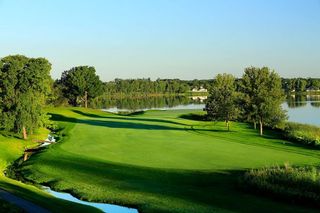Hazeltine: The Ryder Cup course explained
All you need know - well quite a lot of it anyway - about the The Ryder Cup course set up at Hazeltine


All you need know - well quite a lot of it anyway - about the 2016 The Ryder Cup course set up at Hazeltine
Where is it? In Chaska which is just outside of Minneapolis in Minnesota
What is it? A private members club.
How old is it? It opened in 1962
Why was it built? Totton P. Heffelfinger, a past president of the United States Golf Association, wanted to create, according to the club’s mission statement “a golf course and related facilities suitable for the conduct of national championships”
Did he succeed in this aim? Not half. With the Ryder Cup, the club now becomes only the second one to have hosted a clean sweep of the US Open, USPGA Championship, US Senior Open, US Women’s Open, US Amateur, and the Ryder Cup
Which club was the first? Pinehurst
Get the Golf Monthly Newsletter
Subscribe to the Golf Monthly newsletter to stay up to date with all the latest tour news, equipment news, reviews, head-to-heads and buyer’s guides from our team of experienced experts.
Who designed the course? Robert Trent Jones.

What type of course is it? A parkland one with small greens, narrow fairways and water on half the holes.
Has it been changed much? Yes. It had several tweaks, by both Trent Jones and, more recently, his son Rees. After the opening day of the US Open of 1970, when almost half the field failed to break 80 there was much criticism of the course‘s difficulty. As a result, a major reworking was carried out in the1970s.
Any specific changes for this Ryder Cup? Yes, lots. The main one is that the course has been re-routed. The players now start at the 1st, play the first four holes then swap over to the back nine and play holes 14-18. The back nine then runs 10-13, then swaps over to the front nine as it finishes with 5-9.
Why? Twofold. One reason is it marshals spectators better around the site, The Ryder Cup, with so few games on the course, can have large crowds going round in huge bunches, especially at the end of a session, when maybe only one or two game are still out there. The last few holes on the front nine were reckoned to provide better mass spectator viewing than the end of the back nine.

And the other reason? The best holes are considered to be 16 and 17 and having them at 7 and 8 on the Ryder Cup course means they will be played by every match. Matchplay games do not always go down 16 and especially 17.
Stats for this? In the last Ryder Cup, at Gleneagles in 2014, eight of the 28 matches did not go to the 16th hole, and 13 did not go to the 17th hole.
So what are these holes like then? Both the nines have their penultimate holes as fine par 3. Both are attractive short one shotters to green defended by bunkers and water. The Ryder Cup course 8th is also one of the toughest greens on the layout.
And the Ryder Cup course 7th hole? A par-4 cape hole. It arcs around Hazeltine Lake with the lake on the right, and on the left is a creek. The green is elevated and narrow. Johnny Miller described it as “probably the hardest par four I ever played.”
Contributing Writer Golf courses and travel are Roderick’s particular interests and he was contributing editor for the first few years of the Golf Monthly Travel Supplement. He writes travel articles and general features for the magazine, travel supplement and website. He also compiles the magazine's crossword. He is a member of Trevose Golf & Country Club and has played golf in around two dozen countries. Cricket is his other main sporting love. He is the author of five books, four of which are still in print: The Novel Life of PG Wodehouse; The Don: Beyond Boundaries; Wally Hammond: Gentleman & Player and England’s Greatest Post-War All Rounder.
-
 'Gator Netting Is In Place' - Chevron Championship Venue Prepared For 'Safe' Winner's Jump
'Gator Netting Is In Place' - Chevron Championship Venue Prepared For 'Safe' Winner's JumpA tradition which began at the tournament's previous home could continue this year - if the champion is feeling brave enough...
By Jonny Leighfield Published
-
 New Balance 997 SL Golf Shoe Review
New Balance 997 SL Golf Shoe ReviewNew Balance produce some extremely stylish footwear and, in this review, Matt Cradock takes their spikeless 997 SL onto the course
By Matt Cradock Published